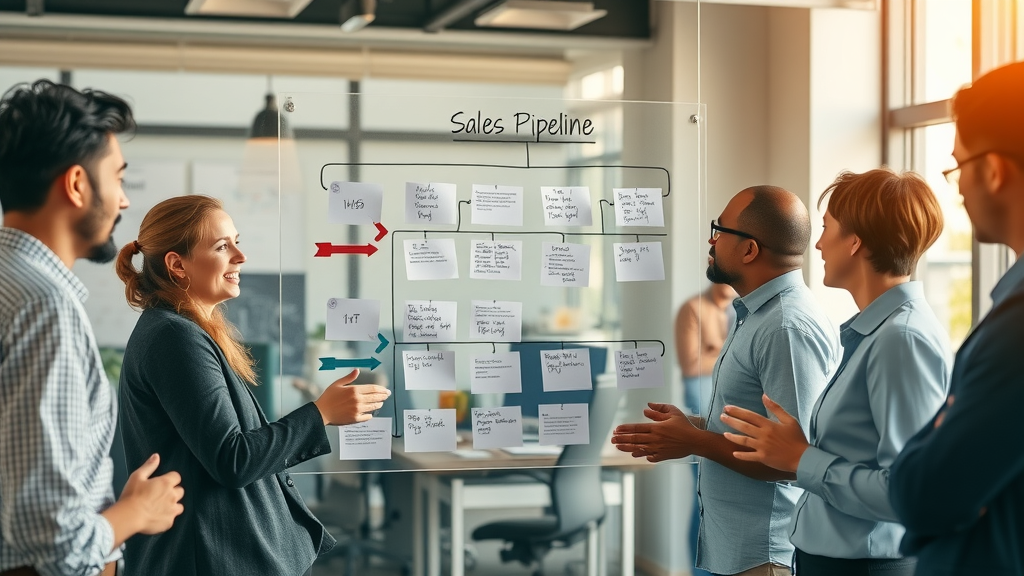Did you know that nearly 80% of B2B sales leads never convert into sales due to poor lead management? This alarming statistic underscores the critical importance of getting lead gen and lead management right—your revenue depends on it. In this article, you'll learn the best tips for B2B lead management that industry leaders use to redefine success, accelerate growth, and outpace competitors with cutting-edge lead gen techniques.
Get ready to unlock a higher sales pipeline velocity , achieve better lead quality, and witness your sales team hit quota more often—all by mastering the latest methods in B2B lead management.
Unlocking Sales Growth: Why the Best Tips for B2B Lead Management Fuel Stellar Sales Lead Gen
- Shocking Statistic: Up to 79% of B2B marketing leads fail to convert due to ineffective management and misalignment between the sales team and marketing team.
- Industry Leaders' Approach: Top companies are redefining success with innovative lead generation strategies, hyper-targeted campaigns, and by leveraging real-time lead data to spot high-quality leads before the competition.

Achieving Success with the Best Tips for B2B Lead Management: What You Will Master
- Understand the critical role of lead generation in sales effectiveness
- Identify and prioritize quality leads through robust lead scoring
- Apply actionable B2B lead management tactics to increase sales
- Streamline your sales pipeline using powerful tools and marketing automation
Mastering Lead Generation: The Foundation of Best Tips for B2B Lead Management
Understanding Sales Lead Gen: Core Concepts and Their Impact
At the core of successful B2B lead management lies the art and science of lead generation—identifying, nurturing, and converting potential customers into qualified leads. Lead gen isn’t just about collecting emails or lists; it’s about attracting businesses actively seeking your product or service and guiding them through a clear sales process. Companies who focus on effective lead generation see a measurable increase in lead quality, pipeline pace, and revenue predictability.
The reason why lead generation and sales lead management are so crucial is that B2B buying cycles are often long and complex. Multiple stakeholders, evolving pain points, and strict budget controls require your sales team to become advisors rather than order-takers. Therefore, top-performing organizations develop a lead gen strategy grounded in real-time lead data, ensuring only quality leads are passed to the sales team.

Key Elements that Drive Effective Lead Generation and Lead Quality
Generating high-quality leads relies on several key elements: a well-defined target audience, persuasive messaging, strategic channel selection (like social media and content marketing), and rigorous measurement of outcome metrics. Your sales lead quality is determined by how accurately your campaigns reach decision-makers and address their true pain points.
Advanced lead scoring models—using behavioral and demographic data—empower both marketing and sales teams to focus effort where it matters most. Integrating technologies like CRM and marketing automation helps filter out unqualified leads and enhances lead nurturing, ensuring a steady stream of qualified leads enters the sales pipeline. In sum, effective lead generation is a blend of art (personalization) and science (data-driven lead scoring).
Strategic Lead Qualification: Turning Potential Customers into Qualified Leads
Defining Quality Leads in the B2B Sales Process
Not all sales leads are created equal—especially in B2B where the stakes are high and the buying journey is complex. Defining a quality lead means establishing clear criteria that separate potential customers ready to buy from those merely browsing. These criteria might include budget, authority, need, and timeline—forming the backbone of effective qualification frameworks like BANT or CHAMP.
Your ideal customer profile serves as a blueprint for qualification. The more closely a prospect matches this profile, the higher their likelihood of converting and generating long-term value. Quality leads show explicit interest, engage with content, respond to outreach, and meet demographic or firmographic requirements. This makes strategic lead qualification not just about filling the pipeline, but filling it with potential customers most likely to close.
Lead Scoring Models: How to Identify Qualified Leads from Sales Leads Data
Lead scoring assigns numerical values to leads based on how well they align with your ideal customer profile and how they interact with your sales and marketing touchpoints. Data points such as website activity, download behavior, email engagement, and social media interaction inform your scoring process. Higher scores correlate with readiness and willingness to engage in the purchasing process.
By building a dynamic lead scoring system with input from both the sales team and marketing team , you ensure that only prospects who have demonstrated true buying signals are prioritized as qualified leads. Regularly revisiting and tweaking your scoring criteria is essential to stay ahead of evolving markets and shifting buyer behaviors. An effective lead scoring model accelerates your sales cycle, reduces wasted effort, and maximizes the ROI of your lead gen initiatives.
| Metric | Description | Impact on Sales Pipeline |
|---|---|---|
| Lead Quality | Assessment of how closely a lead matches the ideal customer profile and purchase intent | High-quality leads yield faster sales cycles and higher conversion rates |
| Lead Scoring | Numerical evaluation based on behavior, engagement, and demographic fit | Prioritizes the best potential customers, improving team productivity |
| Ideal Customer Profiles | Detailed description of your perfect prospect by company size, industry, role etc. | Guides marketing campaigns and ensures sales efforts are focused |
| Conversion Rate | Percentage of leads who become paying customers | Direct indicator of pipeline effectiveness and ROI |

Optimizing the Sales Pipeline: Best Tips for B2B Lead Management at Every Stage
Sales Process Mapping: Lead Gen to Conversion
Mapping your sales process ensures every lead moves seamlessly from initial interest to closed deal without falling through the cracks. A well-constructed process includes defined stages—lead capture, qualification, nurturing, handoff, and closure—each with clear responsibilities for the sales team and marketing team. This step-by-step tracking lets you measure where leads stall, optimize touchpoints, and accelerate deal velocity.
Effective sales process mapping leverages lead data to identify bottlenecks; perhaps too many leads drop after the demo, or not enough are nurtured via email. By visualizing your sales funnel and integrating real-time feedback from both teams, you create a living system that adapts to market trends and consistently drives conversion rates higher.

Seamless Lead Handoff: Aligning the Sales Team and Marketing Team
Alignment between sales and marketing teams is a cornerstone of effective B2B lead management. Often, companies lose sales leads due to miscommunication or unclear ownership—marketing claims success for generating volume, but sales struggle with lead quality. A seamless handoff process involves shared definitions, regular communication, and integrated systems to ensure that every qualified lead receives timely and relevant follow-up.
Utilize service level agreements (SLAs) that define exactly what constitutes a qualified lead and when marketing hands it off to sales. Set up synchronized dashboards and regular alignment meetings to foster a collaborative culture. When the handoff is seamless, your teams can jointly increase sales lead conversion while reducing wasted effort and friction.
Enhancing Lead Generation with Landing Pages, Social Media, and Marketing Campaigns
Landing Page Optimization: Attracting the Target Audience and Boosting Lead Quality
An optimized landing page is one of the most powerful tools for attracting your target audience and improving lead quality. Well-designed B2B landing pages feature clear calls to action, persuasive copy, and trust-building elements such as client logos, testimonials, or relevant case studies. The goal is to create a frictionless path from content consumption to conversion for potential customers.
A/B testing is vital for landing page success—experiment with headlines, offers, and page layout to maximize your conversion rate. Supporting visuals and concise messaging that address the specific pain points of your target audience will dramatically increase the percentage of high-quality lead submissions and support overall sales pipeline health.

Social Media Strategies for Reaching Potential Customers and Driving Sales Leads
Social media is no longer just a brand awareness tool; it’s a powerhouse for lead generation in B2B. Platforms such as LinkedIn, Twitter, and even Facebook provide robust targeting features to reach decision-makers in your target market. Sharing insightful content, engaging in relevant communities, and running highly targeted campaigns can attract potential customers and generate sales leads efficiently.
To maximize ROI, align your social media strategy with your broader marketing campaigns. Utilize social listening tools to uncover industry pain points and join conversations that matter to your prospects. Consistent posting, coupled with targeted advertising and retargeting, ensure your messaging resonates—moving leads further down the funnel toward becoming high-quality leads.

Campaign Case Studies: Successful Lead Generation Tactics in Action
Reviewing real-world case studies allows organizations to see which B2B lead generation tactics produce measurable results. For example, a SaaS provider might use integrated webinars and value-driven blog posts to educate potential customers and move them rapidly through the funnel. Meanwhile, an enterprise IT firm may experience outstanding success by offering a downloadable white paper tailored to industry trends, capturing higher quality leads from segmented social ad campaigns.
The most successful case studies consistently leverage multi-channel strategies: combining landing pages with email nurturing, personalized follow-ups, and direct outreach. By analyzing and adopting best practices from these campaigns, you can replicate their impact—turning theoretical strategies into actionable steps for your sales team and marketing team.
Leveraging Marketing Automation & Technology: Smarter B2B Lead Management
Marketing Automation Tools for Lead Data Management and Sales Pipeline Optimization
Modern marketing automation platforms have revolutionized B2B lead management. Tools like HubSpot, Marketo, and Pardot automate repetitive tasks such as email follow-ups, lead nurturing, and scoring, freeing up your sales team to focus on genuine conversations. Centralizing lead data in a unified dashboard empowers both marketing and sales reps to act quickly on new opportunities and better track the sales pipeline.
By automating lead assignment, scoring, nurturing flows, and even chatbot engagement, businesses ensure that no high-potential lead slips through the cracks. Automation accelerates the sales process, boosts conversion rates, and provides real-time visibility into campaign performance for smarter decisions.

Integrations that Matter: Maximizing the Impact of Marketing Teams
To achieve peak efficiency, integrate your marketing automation platform with your CRM, communication, and analytics tools. Seamless integration ensures real-time sharing of lead data , maintaining accurate records of every sales lead and interaction. This gives both the sales team and marketing teams a 360-degree view of each potential customer.
Whether it's syncing emails, calendars, or tracking responses from marketing campaigns, robust integrations eliminate manual entry errors and support fast, data-driven decisions. The result: a more productive organization, where both teams collaborate, respond faster, and convert more qualified leads into closed revenue.
“Companies with mature lead management practices enjoy over 9% higher sales quota achievement.” – Source: HubSpot
Targeting the Ideal Customer: Audience Segmentation for Higher Lead Quality
Defining Your Target Audience through Lead Gen Data
Effective B2B lead management begins with a crystal-clear definition of your target audience . Analyzing lead gen data enables marketing teams to segment prospects based on firmographics, behavior, and digital engagement patterns. Identifying trends in this data refines your outreach, ensuring resources are focused on the most promising segments.
This segmentation directly impacts both lead quality and campaign performance—enabling highly tailored marketing campaigns that address the unique needs of each audience slice, resulting in increased conversion rates at every phase of the sales pipeline.

Pain Points and Buyer Personas: Creating Irresistible Offers for Qualified Leads
Understanding your prospects’ pain points and constructing detailed buyer personas are critical to maximizing sales conversions. High-quality leads are most likely to respond when your messaging addresses specific challenges their business faces, offering a compelling path to resolution via your product or service.
Developing irresistible offers , whether gated content, demos, or free audits, ensures that you capture the attention of the most qualified leads. An ongoing dialogue with your sales reps and analysis of previous campaign successes helps iteratively refine these personas, keeping your marketing efforts locked on target.
Building Trust with Relevant Blog Posts, Case Studies, and Content
Content is king in the world of B2B lead management. High-value blog posts , in-depth case studies, and data-rich resources establish your brand as an industry thought leader, accelerating trust-building with potential customers. The key is to publish content that not only answers questions but anticipates pain points and offers actionable solutions.
Sharing real-world case studies and testimonials demonstrates proven results and gives prospects the confidence to move forward. Educational webinars, eBooks, and industry roundups keep your company top-of-mind throughout the long sales cycle, turning content into a versatile sales enabler for your team.
Aligning Sales and Marketing for Outstanding B2B Lead Management Results
Cultivating a Collaborative Sales and Marketing Culture
The alignment of sales and marketing is essential to achieving consistent B2B lead management success. Functional silos lead to wasted efforts, misaligned messaging, and missed revenue targets. A culture of collaboration—where both teams share data, goals, and regularly meet to review pipeline performance—produces outstanding sales results.
Implement regular cross-departmental training sessions to foster deeper understanding and empathy between teams. Joint accountability for KPIs, such as conversion rates and lead quality, transforms the traditional rivalry into a powerhouse partnership driving sustainable growth.

Metrics that Matter: Tracking and Improving Lead Quality Together
The only way to drive continuous improvement is to rigorously track lead quality and conversion rates across the sales pipeline. Set up joint dashboards for the sales team and marketing team, focusing on KPIs like SQL/MQL ratios, time-to-close, and pipeline velocity.
Monthly review sessions centered on data uncover insights on which campaigns drive the most high-quality sales leads and where adjustments are needed. When both teams measure and optimize together, all segments of funnel performance can continually improve, producing sustainable higher ROI.
Nurturing Leads to Close: Transforming Potential Customers into Long-term Clients
Lead Nurturing Campaigns That Move Prospects Down the Sales Pipeline
A robust lead nurturing campaign is what transforms interested prospects into committed buyers. Effectively guiding potential customers through the stages of the sales pipeline requires a well-timed cadence of informative emails, value-driven content, and personalized touchpoints. Tailored nurturing acknowledges the unique needs and pain points of each lead.
Map your nurturing flows to typical sales cycle milestones—awareness, consideration, decision—to ensure ongoing engagement. The most successful B2B campaigns align nurturing activities with real-time lead behavior, sending the right message at precisely the right moment to maximize conversion rates.
Using Personalized Content and Marketing Automation to Engage Sales Leads
Personalization is the secret weapon for engaging modern B2B sales leads. By leveraging marketing automation, businesses can deliver content, invitations, and offers tailored to a lead’s interests and stage in the buying journey. Segment your email lists and create dynamic content blocks for highly relevant messaging.
This strategy not only increases the engagement rates but significantly improves the quality of leads entering your sales pipeline. When potential customers feel understood and valued, their trust and intent to purchase rise sharply—driving your pipeline forward with minimal friction.
Measuring Success: Key Metrics for the Best Tips for B2B Lead Management
Analyzing Conversion Rates, Lead Quality, and Sales Team Performance
Measuring success in B2B lead management revolves around three pivotal metrics: conversion rates, lead quality, and sales team performance. Conversion rates at each funnel stage illuminate the health of your pipeline—do enough leads move from inquiry to close? Lead quality metrics judge the true potential of each new sales lead, while sales team performance tracks efficiency in outreach, follow-up, and closure.
Establishing transparent reporting protocols and sharing analytics dashboards between departments ensures everyone stays aligned and empowered to make data-driven optimizations. In turn, this leads to higher quota attainment and tangible revenue growth.

Continuous Improvement: A/B Testing, Feedback Loops, and Data-Driven Lead Gen
The top-performing organizations treat lead gen as an ongoing experiment. Running A/B tests on landing pages, emails, and campaign offers delivers actionable insight into what works best for your unique audience. Building structured feedback loops—where both the sales team and marketing team share learnings—closes the gap between theory and practice.
Data-driven decision making, supported by integrated analytics and ongoing campaign benchmarking, ensures your B2B lead management strategy stays agile and impactful. Adjusting tactics based on real-world outcomes keeps your organization ahead of evolving buyer expectations.
| KPI | Description | Target Value |
|---|---|---|
| MQL to SQL Conversion Rate | Percentage of marketing qualified leads that become sales qualified leads | 30-40% |
| Average Sales Cycle Length | Time from first contact to closed-won opportunity | 60 days |
| Lead Quality Score | Weighted score based on fit, intent, and engagement | 80+ out of 100 |
| Revenue Growth | Year-over-year increase in sales-generated revenue | 15%+ |
People Also Ask: How to Improve B2B Lead Generation?
Strategies for Enhancing B2B Lead Generation and Boosting Sales Leads
To enhance B2B lead generation , start by refining your ideal customer definition and focusing on lead quality over quantity. Employ marketing automation for nurturing, and align your content to address target audience pain points. Deploy A/B tested landing pages, leverage multi-channel social media strategies, and use robust lead scoring to ensure that only high-potential leads progress to your sales team.
Consistent measurement and feedback between marketing teams and sales reps identify which tactics drive the best conversion rates, while targeted campaigns and thoughtful email sequences help maintain momentum throughout longer B2B sales cycles.
People Also Ask: What Is a Good B2B Lead Conversion Rate?
Benchmarks and Best Practices for B2B Lead Conversion Rates
A strong B2B lead conversion rate typically ranges between 2% and 10%, depending on the industry, offer, and sales cycle complexity. Top-performing organizations go beyond this by meticulously tracking lead-to-customer conversion and adjusting their processes and messaging accordingly.
Improving conversion rates begins with cleaning your data, defining what qualifies a sales lead, and employing both marketing automation and personalized outreach. Continually optimize based on detailed analytics and real-life feedback from sales reps and potential customers.
People Also Ask: What Are the New Rules of B2B Lead Generation?
Modern Principles Transforming Lead Gen and Sales Lead Management
Today's B2B lead generation is driven by data, speed, and hyper-personalization. The new rules demand tighter sales and marketing alignment, continuous testing and refinement, and a relentless focus on lead quality over volume. Smart organizations use marketing automation to nurture and segment, while integrating outreach across multiple digital touchpoints.
Building trust with helpful content, responding rapidly to inbound queries, and tailoring offers based on a granular understanding of buyer personas are now essential. Measure what matters and adjust quickly for maximum sales impact.
People Also Ask: What Is the B2B Lead Generation Process?
Step-by-Step Overview of the B2B Lead Generation and Management Pipeline
The B2B lead generation process follows a structured pipeline: identify the target audience, create compelling content and offers, capture leads via landing pages, qualify and score each lead, and nurture through automated and personalized campaigns. High-quality leads are then handed seamlessly to the sales team, where follow-up and closing activities occur.
Along every stage, robust metrics and real-time lead data enable ongoing optimization—ensuring that sales and marketing are always aligned and focused on converting the right leads at the right time.
Real-World Success: B2B Lead Management Case Studies for Maximizing Lead Gen
Case Study #1: Improving Lead Quality and Conversion for a SaaS Firm
A leading SaaS firm revamped its lead gen process by refining buyer personas, implementing behavior-based lead scoring, and automating nurturing flows. The result was a 37% increase in high-quality sales leads, with a 22% bump in overall conversion rates in just six months.
By closely aligning sales and marketing through integrated technology, the team was able to react faster to buying signals and reduce lead response time to under five minutes—dramatically improving both customer experience and pipeline value.
Case Study #2: Social Media-Driven B2B Lead Generation
A B2B consulting company utilized LinkedIn’s powerful targeting tools to deliver tailored content offers to decision-makers in its core markets. By running coordinated ad campaigns and nurturing landed leads with a mix of webinars and email sequences, the company doubled its lead-to-appointment rate and filled the pipeline with highly qualified leads.
This case study highlights the effectiveness of direct social media engagement, data-driven channel selection, and follow-up content in closing the gap between marketing and sales.
Lessons from High-Performing Sales Teams and Marketing Campaigns
The most successful teams keep their focus on continuous process improvement, real-time communication between sales reps and marketing teams, and always putting lead quality above quantity. These lessons drive lasting results, helping brands stay resilient and adaptable even in volatile market conditions.
List: Best Tips for B2B Lead Management to Maximize Sales
- Identify your target audience and refine buyer personas
- Prioritize lead quality using robust lead scoring
- Deploy landing pages and marketing automation for efficiency
- Align sales and marketing teams for seamless handoff
- Nurture leads with personalized content
- Measure performance and optimize campaigns
- Continually update processes based on market feedback and data
Expert Advice and Industry Quotes: Boosting Your Lead Gen Strategy
“The best tips for B2B lead management involve constant testing, tight sales and marketing alignment, and a relentless focus on lead quality.” – B2B Marketing Leader
Common Mistakes in B2B Lead Management and Lead Gen (And How to Avoid Them)
- Ignoring potential customers’ pain points and failing to create relevant offers
- Overlooking the crucial role of sales and marketing teams collaboration
- Not revisiting lead scoring methods regularly as market shifts
- Failing to segment lead data by behavior or business needs
- Under-investing in landing page and content optimization
Frequently Asked Questions on the Best Tips for B2B Lead Management
- What are the challenges in identifying quality leads? Challenges include incomplete or outdated data, unclear qualification criteria, and lack of alignment between sales and marketing teams. Regularly updating your lead scoring models and maintaining open communication between departments can help overcome these obstacles.
- How does lead gen in B2B differ from B2C? B2B lead generation often involves longer sales cycles, multiple decision-makers, and more complex buyer journeys than B2C. Strategies are therefore more focused on nurturing relationships, delivering personalized and highly relevant content, and targeting strictly defined audiences.
- What role does data privacy play in B2B lead management? Data privacy is integral, with regulations like GDPR and CCPA requiring companies to secure consent before collecting and processing data. Transparent data practices and compliant technologies protect both your business and your leads.
- How should I follow up with sales leads efficiently? Efficient follow-up involves quick response times, personalized communication, and a structured cadence. Using marketing automation and CRM tools ensures no lead is left behind and every potential lead is nurtured appropriately.
- What KPIs should my sales team track? Key KPIs include MQL to SQL conversion rate, average sales cycle length, lead quality score, total revenue attributed to lead gen, and time to first contact. Joint dashboards are a great tool for tracking and optimizing these metrics collaboratively.
Summary of the Best Tips for B2B Lead Management and Your Next Steps
- Embrace a holistic strategy combining technology, collaboration, and data-driven insights to supercharge lead generation and sales outcomes. Implement these proven tips to outpace the competition and achieve sustained B2B growth.
 Add Row
Add Row  Add
Add 




Write A Comment